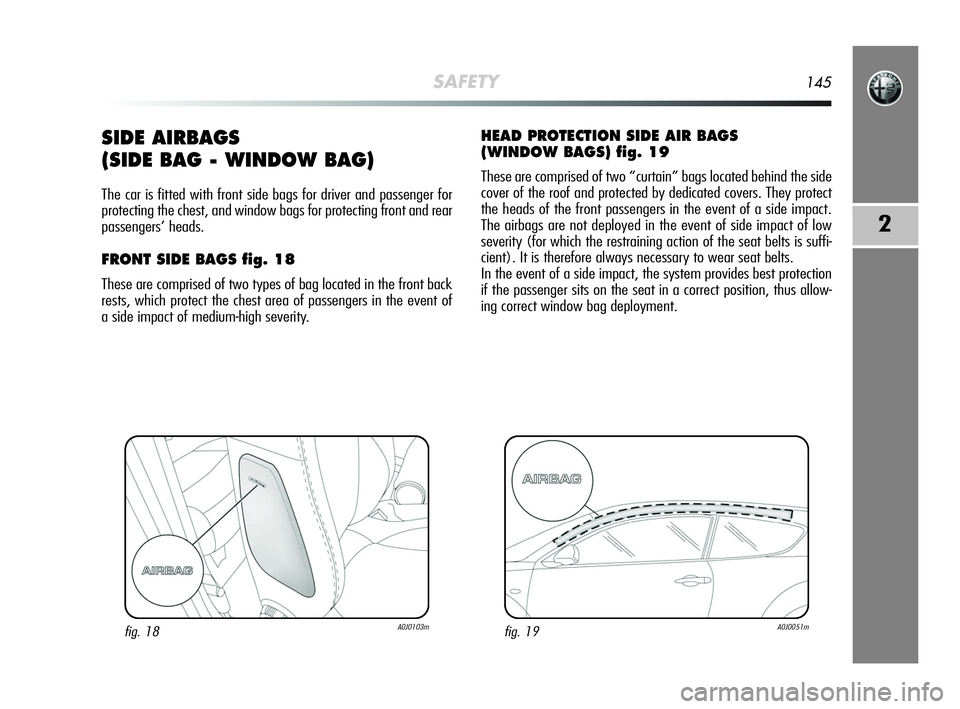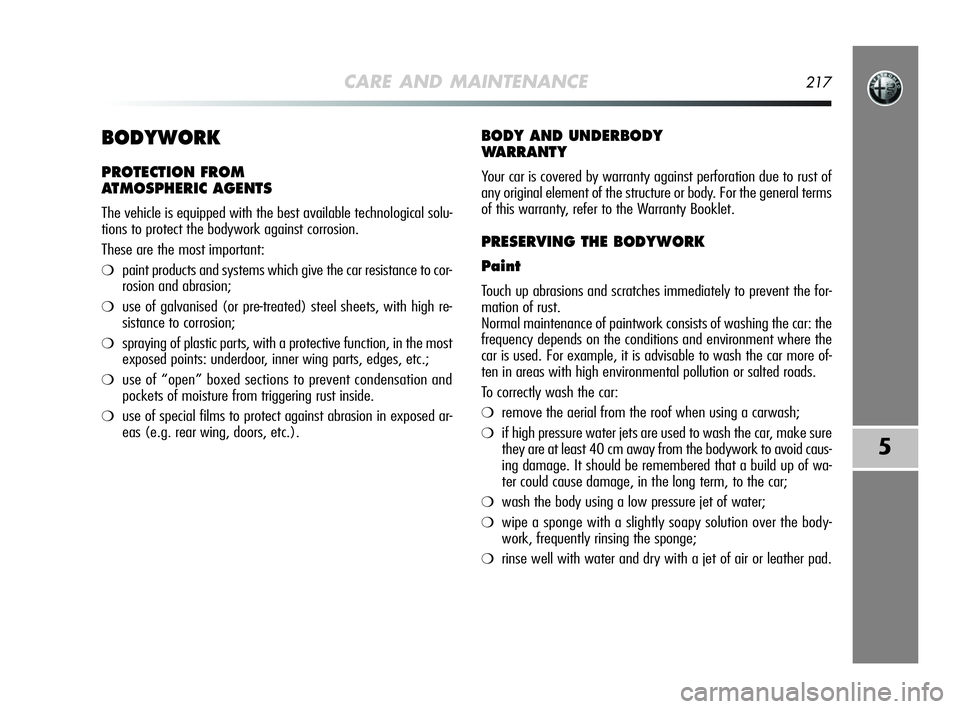2009 Alfa Romeo MiTo roof
[x] Cancel search: roofPage 118 of 250

GETTING TO KNOW YOUR CAR117
1
RADIO TRANSMITTERS AND CELLULAR PHONES
Radio sets (e.g. mobile phones, CB radio systems and the like)
cannot be used inside the car unless a separate aerial is mounted
on the roof.
IMPORTANT The use of these devices inside the passenger com-
partment (without a separate aerial) may cause the vehicle elec-
trical systems to malfunction. This could compromise safety in ad-
dition to constituting a potential hazard for passengers.
In addition, transmission and reception of these devices may be af-
fected by the shielding effect of the car body. With regards to the
use of EC-approved mobile phones (GSM, GPRS, UMTS), adhere
strictly to the instructions for use provided by the mobile phone
manufacturer.
PARKING SENSORS
(where provided)
The parking sensors are located in the rear bumper fig. 73 and their
function is to inform the driver, through an intermittent buzzer, of
the presence of obstacles behind the car.
ACTIVATION
The sensors are activated by engaging reverse gear. As the distance
from the obstacle behind the car decreases, the acoustic alarm
becomes more frequent.
fig. 73A0J0088m
001-126 Alfa MiTo GB 13-11-2008 10:08 Pagina 117
Page 143 of 250

142SAFETY
FRONT AIRBAGS
The vehicle is equipped with multi-stage front air bags (“Smart
bag”) for the driver and passenger and knee air bag for the dri-
ver.
“SMART BAG” SYSTEM
(MULTISTAGE FRONT AIR BAGS)
The front airbags (driver’s and passenger’s) and the driver knee
air bag have been designed to protect the occupants in the event
of head-on crashes of medium-high severity, by placing the cush-
ion between the occupant and the steering wheel or dashboard.
The air bag do not replace, but rather compliment the use of seat
belts, which should always be worn. In the event of a collision, a
person not wearing a seat belt may be thrown forward and come
into contact with the bag before it has fully opened. The protection
offered by the bag is reduced in such a case.
Front airbags may not be activated in the following situations:
❍in collisions against highly deformable objects not affecting the
car front surface (e.g. bumper collision against guard rail, etc.);
❍car penetration under other vehicles or protective barriers (e.g.
trucks or guard rails);
in these instances they could not provide any additional protec-
tion compared with seat belts, so their deployment would not be
useful. Non deployment in such cases does not constitute a fault.
FRONT AIRBAG ON DRIVER’S SIDE fig. 15
This is located in a dedicated compartment in the centre of the steer-
ing wheel.
Do not apply stickers or other objects on the steer-
ing wheel, passenger side airbag cover or side up-
holstery on roof. Do not place objects on the pas-
senger side dashboard because these could interfere with
the correct opening of the airbag and cause severe in-
jury to occupants.
fig. 15A0J0047m
127-148 Alfa MiTo GB 12-11-2008 15:41 Pagina 142
Page 146 of 250

SAFETY145
2
SIDE AIRBAGS
(SIDE BAG - WINDOW BAG)
The car is fitted with front side bags for driver and passenger for
protecting the chest, and window bags for protecting front and rear
passengers’ heads.
FRONT SIDE BAGS fig. 18
These are comprised of two types of bag located in the front back
rests, which protect the chest area of passengers in the event of
a side impact of medium-high severity.
HEAD PROTECTION SIDE AIR BAGS
(WINDOW BAGS) fig. 19
These are comprised of two “curtain” bags located behind the side
cover of the roof and protected by dedicated covers. They protect
the heads of the front passengers in the event of a side impact.
The airbags are not deployed in the event of side impact of low
severity (for which the restraining action of the seat belts is suffi-
cient). It is therefore always necessary to wear seat belts.
In the event of a side impact, the system provides best protection
if the passenger sits on the seat in a correct position, thus allow-
ing correct window bag deployment.
fig. 18A0J0103mfig. 19A0J0051m
127-148 Alfa MiTo GB 12-11-2008 15:41 Pagina 145
Page 155 of 250

154STARTING UP AND DRIVING
SAVING FUEL
Here are some suggestions which may help you to save fuel and
lower the amount of toxic emissions released into the atmosphere.
GENERAL CONSIDERATIONS
Car maintenance
Have checks and adjustments carried out in accordance with the
“Scheduled servicing plan”.
Tyres
Check tyre pressure regularly, at least once every four weeks: ex-
cessively low pressure will increase fuel consumption because rolling
resistance will be higher.
Unnecessar y loads
Do not travel with an overloaded boot. The weight of the car and
its ride setting greatly affect fuel consumption and stability.
Roof rack/ski rack
Remove the roof rack or the ski rack from the roof after use. These
accessories decrease aerodynamic penetration of the car and have
a negative effect on fuel consumption. It is better to use a trailer,
particularly for transporting bulky objects.
Press the clutch pedal fully to change gears cor-
rectly. For this reason, there must be no obstacles
on the floor under the pedals: ensure that any rub-
ber mats are correctly positioned, and do not interfere
with the pedals
Do not drive with your hand resting on the gear
lever, because this pressure, even if light, can wear
out the gearbox internal components over time.
149-158 Alfa MiTo GB 12-11-2008 15:41 Pagina 154
Page 192 of 250

5
7.5
5
5
15
10
15
20
IN AN EMERGENCY191
4
43
43
43
43
45
45
45
45F49
F50
F51
F53
F4
F5
F6
F1
CONSUMERS FUSE AMPERE FIGURE
Parking sensors control unit, Tyre pressure
detection control unit, Rain/dusk sensor
on rear-view mirror, Electro-chrome sensor
on rear-view mirror, Seat belts fastened
warning light display on rear-view mirror,
Control panel illumination (Central control
panel, Driver-side control panel, Steering wheel
control panel, Blue&Me
TMcontrol panel),
Front seat heating pad activation switch,
Alarm system volume-sensing sensors control unit,
Electric sunroof control unit,
PND socket on dashboard
Air Bag system control unit
Clutch switch, Brake light
switch, relay coils on
engine fuse box, Control system on
internal heater/air conditioning unit,
Blue&Me
TMcontrol unit,
Radio wiring, Air flow meter,
Water in diesel fuel sensor
Instrument panel
Bose HI-FI system amplifier control unit
Bassbox subwoofer in spare wheel compartment
Left and right front seat heater
Electric sunroof opening system
159-196 Alfa MiTo GB 12-11-2008 15:46 Pagina 191
Page 218 of 250

CARE AND MAINTENANCE217
5
BODYWORK
PROTECTION FROM
ATMOSPHERIC AGENTS
The vehicle is equipped with the best available technological solu-
tions to protect the bodywork against corrosion.
These are the most important:
❍paint products and systems which give the car resistance to cor-
rosion and abrasion;
❍use of galvanised (or pre-treated) steel sheets, with high re-
sistance to corrosion;
❍spraying of plastic parts, with a protective function, in the most
exposed points: underdoor, inner wing parts, edges, etc.;
❍use of “open” boxed sections to prevent condensation and
pockets of moisture from triggering rust inside.
❍use of special films to protect against abrasion in exposed ar-
eas (e.g. rear wing, doors, etc.).
BODY AND UNDERBODY
WARRANTY
Your car is covered by warranty against perforation due to rust of
any original element of the structure or body. For the general terms
of this warranty, refer to the Warranty Booklet.
PRESERVING THE BODYWORK
Paint
Touch up abrasions and scratches immediately to prevent the for-
mation of rust.
Normal maintenance of paintwork consists of washing the car: the
frequency depends on the conditions and environment where the
car is used. For example, it is advisable to wash the car more of-
ten in areas with high environmental pollution or salted roads.
To correctly wash the car:
❍remove the aerial from the roof when using a carwash;
❍if high pressure water jets are used to wash the car, make sure
they are at least 40 cm away from the bodywork to avoid caus-
ing damage. It should be remembered that a build up of wa-
ter could cause damage, in the long term, to the car;
❍wash the body using a low pressure jet of water;
❍wipe a sponge with a slightly soapy solution over the body-
work, frequently rinsing the sponge;
❍rinse well with water and dry with a jet of air or leather pad.
197-220 Alfa MiTo GB 12-11-2008 15:42 Pagina 217
Page 236 of 250

TECHNICAL DATA235
6
(*) If special equipment is fitted (sunroof, tow hitch, etc.) the unladen car weight increases, thus reducing the specified payload with respect to the
maximum permitted load.
(**) Loads not to be exceeded. The driver is responsible for arranging the loads in the boot and/or on the roof so that they comply with these limits.
1145 1145
480 560
950 950
850 850
1625 1705
500 500
400 400
40 40
60 601205 1205
480 560
1000 1000
850 850
1685 1765
1000 1000
400 400
40 40
60 601080 1080
480 560
850 850
850 850
1560 1640
500 500
400 400
40 40
60 601150 1150
480 560
950 950
850 850
1630 1710
1000 1000
400 400
40 40
60 60
WEIGHTS
Weights (kg) 1.4 Petrol1.4 Turbo Petrol1.3 JTDM1.6 JTDM
4 seater 5 seater 4 seater 5 seater 4 seater 5 seater 4 seater 5 seater
Unladen weight
(with all fluids,
fuel tank filled to 90% and
without optional equipment):
Carrying capacity (*)
including the driver:
Maximum permitted loads (**)
– front axle:
– rear axle:
– total:
Towable loads
– trailer with brakes:
– trailer without brakes:
Maximum load on roof:
Maximum load on tow hitch
(trailer with brakes):
221-240 Alfa MiTo GB 5-02-2009 12:04 Pagina 235
Page 240 of 250

TECHNICAL DATA239
6
FUEL CONSUMPTION
The fuel consumption figures given in the table below are deter-
mined on the basis of the homologation tests set down by specif-
ic European Directives.
The procedures below are followed for measuring consumption:
❍urban cycle: cold starting followed by driving that simulates
urban use of the car;
❍extra urban cycle: frequent accelerations in all gears, simulat-
ing extra urban use of the car: speed varies between 0 and
120 km/h;
❍combined fuel consumption: calculated based on about 37%
of urban cycle consumption and about 63% of extra urban con-
sumption.
IMPORTANT The type of route, traffic situations, weather conditions,
driving style, general conditions of the car, trim level/equip-
ment/accessories, load, climate control system, roof rack and oth-
er situations that affect air drag may lead to different fuel con-
sumption levels than those measured.
FUEL CONSUMPTION ACCORDING TO 2004/3/EC DIRECTIVE (litres x 100 km)
7.7
4.8
5.98.5
5.3
6.55.9
4.1
4.88.1
5.0
6.15.4 (*)/6.0 (*)
3.7 (*)/3.6 (*)
4.3 (*)/4.5 (*)
(*) Only for versions/markets where applicable
1.4 Petrol 1.4 Turbo Petrol 1.4 Turbo Petrol 1.3 JTDM1.6 JTDM
120HP 155HP
Urban Cycle
Extra Urban Cycle
Combined Fuel
Consumption
221-240 Alfa MiTo GB 12-11-2008 15:43 Pagina 239